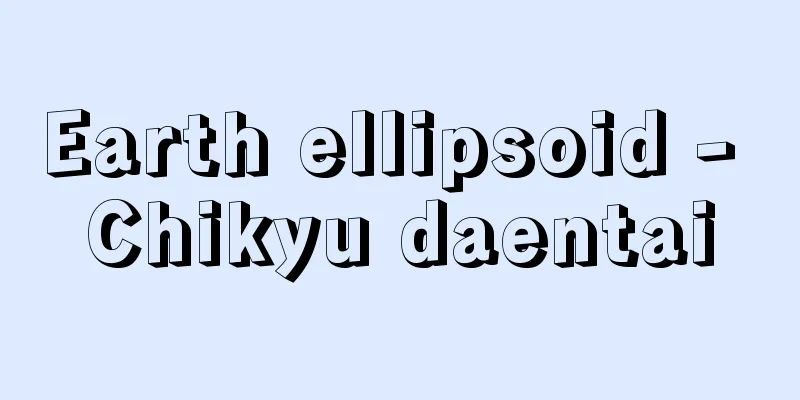Earth ellipsoid - Chikyu daentai

|
The ellipsoid that most closely resembles the shape of the Earth. The shape of the Earth is represented by the geoid. The shape of the geoid is very close to a spheroid formed by compressing a sphere slightly from the north and south. For this reason, ellipsoids that are as close to the geoid as possible are often considered as the simplest possible shape of the Earth. From this perspective, an ellipsoid determined to represent the shape of the Earth is called an Earth ellipsoid. There are three main methods for determining the Earth's ellipsoid: a geometric method based on ground surveys, a geodetic method based on gravity theory using gravity values measured over a wide area of the Earth's surface, and a mechanical method based on satellite observations. The determined Earth's ellipsoid is usually expressed in two quantities: the equatorial radius and the flattening ratio (the difference between the equatorial radius and polar radius divided by the equatorial radius). When making a map, it is necessary to adopt an appropriate earth ellipsoid (called a reference ellipsoid) as the basis. Since the Meiji period, the reference ellipsoid used in Japan was the Bessel ellipsoid, but as surveying became linked on a global scale, it became clear that Japan's geodetic system was out of position with respect to the world's geodetic systems and that there was distortion inside. Thus, measures were urgently required. Eventually, the Survey Act was revised in 2001 (Heisei 13), and Japan's reference ellipsoid was revised to one based on the Geodetic Reference System 1980 in line with the global trend. The equatorial radius of this earth ellipsoid is 6,378.137 km, and the flattening ratio is approximately 1:298.257. [Nagasawa Takumi] "3D Processing of Survey Data - Least Squares Method in the GPS Era" by Katsumi Nakane (1994, Toyo Shoten) " "Yoichiro Fujii, Yoshiki Fujiwara, and Hiroo Mizuno, edited by the Earth Sciences Research Association, "New Edition Earth Science Education Lectures 1: Measuring the Earth" (1994, Tokai University Press)" [Reference] |Source: Shogakukan Encyclopedia Nipponica About Encyclopedia Nipponica Information | Legend |
|
地球の形にもっとも近い楕円体のこと。地球の形はジオイドで代表される。ジオイドの形は、球を南北からほんのすこし押し縮めた回転楕円体にごく近い。そのため、なるべく単純な地球の形として、ジオイドに近い形の回転楕円体を考えることが多い。このような立場で、地球の形を示すものとして決めた楕円体を地球楕円体という。 地球楕円体を決めるには、大きく分けて次の3種の方法がある。地上測量により幾何学的に決める方法、広い範囲の地表で測定した重力値から重力理論に基づいて測地学的に決める方法、人工衛星の観測結果から力学的に決める方法である。決定された地球楕円体は、通常、赤道半径、扁平率(赤道半径と極半径の差を赤道半径で割った値)の二つの量で表される。 地図をつくるときには、その基本として適当な地球楕円体を採用する(準拠楕円体という)必要がある。明治以来、日本で採用していた準拠楕円体はベッセルの楕円体であったが、測量が世界的規模で連結されるようになると、日本の測地系が世界の測地系に対して位置がずれていること、内部にゆがみが存在することが明らかになった。そして、その対策が急がれた。結局、2001年(平成13)に測量法の改正が行われ、世界の大勢にあわせて、日本の準拠楕円体は測地基準系1980(Geodetic Reference System 1980)に基づくものに改訂された。その地球楕円体は、赤道半径が6378.137キロメートル、扁平率がほぼ298.257分の1である。 [長沢 工] 『中根勝見著『測量データの3次元処理――GPS時代の最小2乗法』(1994・東洋書店)』▽『藤井陽一郎・藤原嘉樹・水野浩雄著、地学団体研究会編『新版地学教育講座1 地球をはかる』(1994・東海大学出版会)』 [参照項目] |出典 小学館 日本大百科全書(ニッポニカ)日本大百科全書(ニッポニカ)について 情報 | 凡例 |
>>: Earth Atmosphere Development Plan
Recommend
Oriente - Oriente
… [Nature, Geography] Its area is about three tim...
Chenonceaux (English spelling)
A small village with a population of 358 (1982) lo...
Moromoro (English spelling) moro‐moro
A popular drama performed on a temporary outdoor s...
Caseous necrosis
...Cells that have undergone necrosis swell, stai...
khlysty
...It was only after the 1905 revolution that fre...
Setaria faberii (English spelling) Setaria faberii
…[Tetsuo Koyama]. … *Some of the terminology that...
Drosera indica (English spelling) Droseraindica
…[Katsuhiko Kondo]. … *Some of the terms mentione...
Austrian lip (English spelling) Austrian lip
He explains that black people have thick, turned-...
Auto-ecology
...Human ecology has a strong natural science fla...
Bias - Bias (English spelling)
A DC voltage that is steadily applied to the cont...
Shock absorber - Shock absorber
This refers to springs, anti-vibration rubber, hy...
Ouchi [town] - Ouchi
A former town in Yuri County in the southwest of A...
Neoprene
…In 1931, DuPont first began manufacturing and se...
Maruko [town] - Maruko
A former town in Chiisagata County, south of Ueda ...
Merychippus
...The late Miocene saw the second great radiatio...









